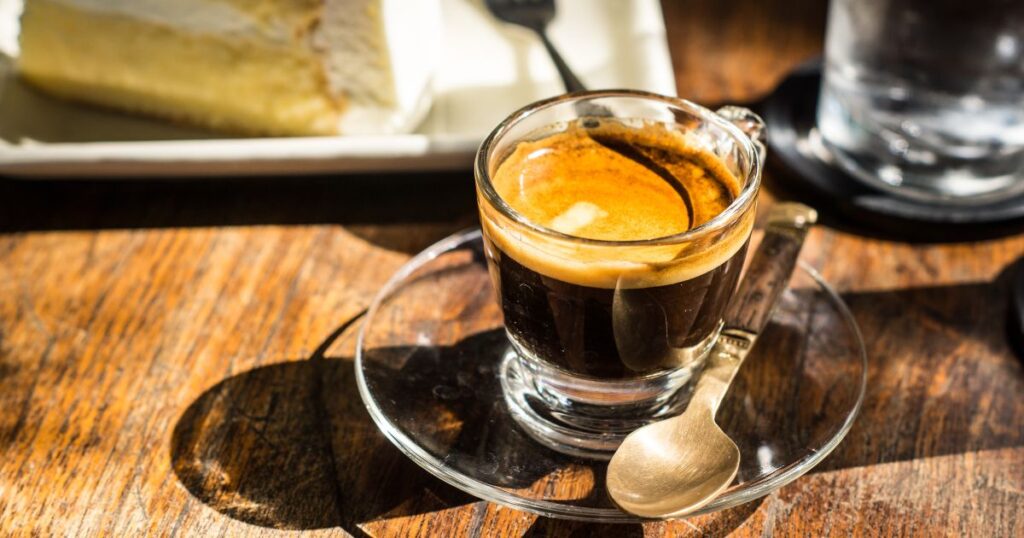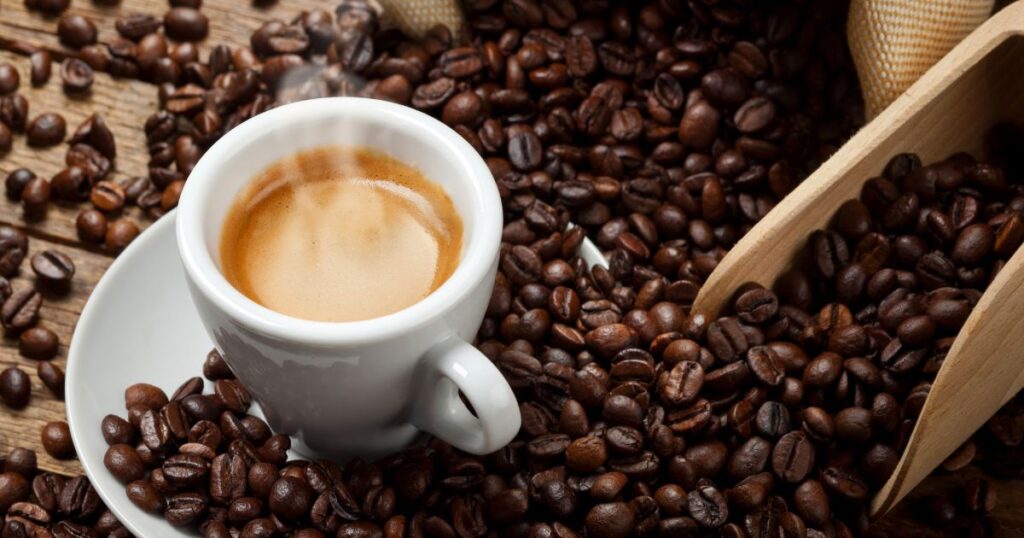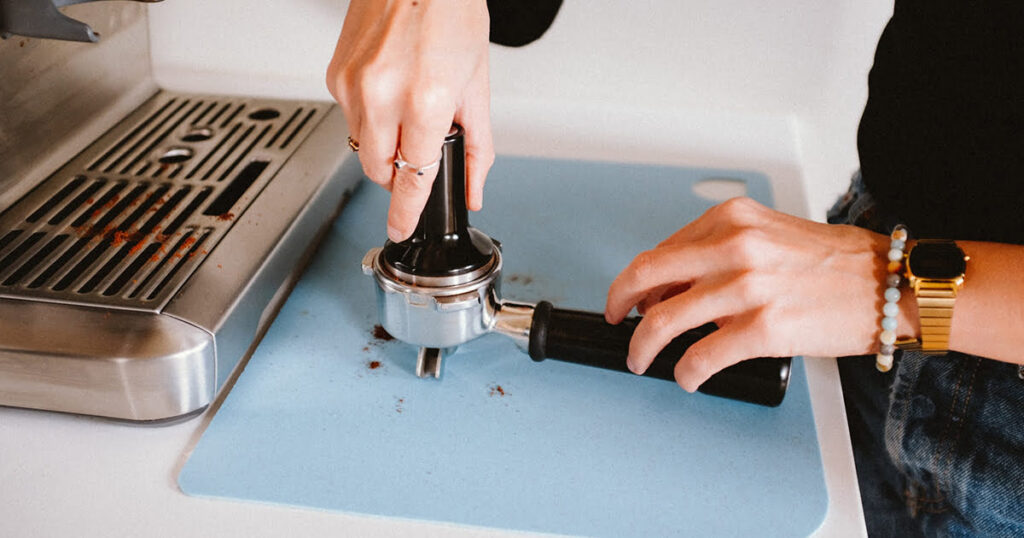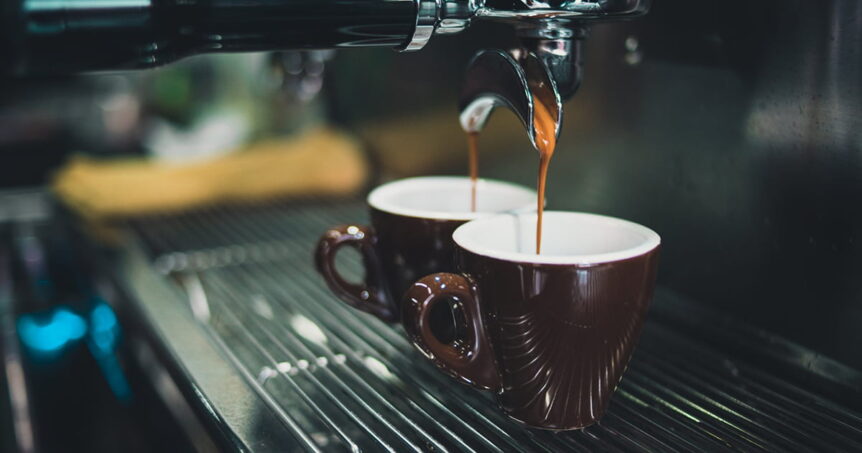Espresso is a concentrated powerhouse of coffee goodness, brewed by passing hot water under high pressure through finely ground coffee beans.
But what’s the deal with espresso? Isn’t coffee just coffee? Well, not quite! Turns out, how you make it can totally change the flavor profile. Espresso packs a punch of unique flavors you won’t find in your regular cup of joe.
In this guide, we will cover everything you need to know about espresso recipe and how you can adjust it to your taste buds. Get ready for some serious espresso knowledge and discover how it conquered the coffee world!
What Is Espresso Coffee?

Coffee has two distinct brewing methods, Boiling and Espresso. Surprisingly, both methods result in totally different tasting coffee cups. Traditionally brewing coffee involves boiling water, a classic example of which is Turkish coffee and Moka pot.
On the other hand, Espresso is made by passing high-pressure (9-10 bars, 130–150 psi) steam through a fine coffee grind, extracting more bioactive ingredients from the beans.
It’s all about that bold flavor and smooth, velvety texture. The aroma is just irresistible, and it tops it all off with a luscious layer of crema (Italian for creamy goodness).
That’s it. There are no different types of coffee beans or secret recipes. The preparation method makes all the difference.
Espresso is a hot topic among coffee lovers because it’s influenced by factors like grind size, tamping, temperature, pressure, and brewing time, leading to passionate debates over its true definition.
What Does Espresso Mean?
The term is derived from the Italian word “caffè espresso,” meaning “pressed-out coffee” or “coffee made on the spot.” When it comes to making espresso coffee, the process is way quicker and extracts way more flavor than your regular brewing methods.
What is an Espresso Made of?
As mentioned earlier, espresso is defined by its preparation method rather than a specific ingredient. The magic of espresso happens thanks to a trusty espresso machine, and we will delve into the details in the following sections.
What Kind of Beans are Used For a Good Espresso?
Coffee is only as good as the beans used to brew it, so any high-quality beans will suffice. We recommend using freshly ground dark-roasted coffee beans, and by “fresh,” we mean beans roasted no more than two weeks ago.
How Much Caffeine Is In Espresso?
According to the USDA (U.S. Department of Agriculture – Agricultural Research Service, an espresso shot contains 212 mg of caffeine per 100 grams. A standard 1-ounce shot of espresso packs around 63 mg of caffeine.
In comparison, your regular cup of joe has an average of 12 to 16 mg of caffeine per ounce. So, if you’re looking for a stronger caffeine kick, espresso’s got your back!
How many calories are in an espresso?
Espresso, being more concentrated than brewed coffee, tends to have a higher calorie content per ounce. Nevertheless, a standard shot of espresso is usually just 1 ounce (30 mL) and contains approximately 2-3 calories.
The History Of Espresso

Back in the day, people wanted their coffee fix pronto. The old-school brewing methods took ages, and they were downright exhausted from waiting hours for a simple cup of joe.
So, genius inventors came along, brewing up espresso machines. These bad boys whipped up delicious shots in no time, giving folks the caffeine kick they craved, fast and furious!
In the early 19th century, Louis Bernard Rabaut, a Frenchman, introduced the world to the first coffee machine in 1822.
Decades later, in 1855, Edouard Loysel de Santais amazed everyone with the café express machine, capable of producing a staggering 2000 cups of coffee per hour.
Although often attributed to Angelo Moriondo (because of his steam-driven coffee machine invention), it was actually Luigi Bezzera, an Italian from Milan, who revolutionized the coffee world. Bezzera patented the first espresso machine in 1901, incorporating several remarkable improvements.
Desiderio Pavoni recognized its potential and acquired the patent in 1903, founding the La Pavoni company to manufacture the machines industrially. The espresso machine made its debut as Bezzera L. Caffè Espresso at the 1906 World’s Fair in Milan, where the term “espresso” was first used.
These inventions transformed the coffee landscape, allowing for faster and more flavorful brews. From Rabaut’s initial creation to Bezzera’s groundbreaking patent, each step paved the way for the rich and aromatic journey we now experience with every cup of espresso.
So let’s raise our cups to these brilliant minds whose ingenuity forever changed how we coffee drinkers enjoy our cup of joe.
Where Is The Espresso From?
Espresso style coffee was first developed and popularized in Italy during the late 19th century and has since become an integral part of coffee shops worldwide.
How To Make Espresso?
Making a perfect espresso takes time, patience, and years of training. Just kidding! Here we will break down complex espresso recipes into simple and easy-to-follow steps.
If you are here reading this, chances are you have already delved into the espresso process and know the basics.
But here, we will go one step further and tell you exactly the thought process behind each step so you can truly master espresso brew and adjust it to your taste.
Step: 1 Gather The Equipment
Having an espresso machine is a must when it comes to making espresso. That’s a given. You have automatic espresso machines, which pretty much do everything on their own, but you have no control over the final outcome.
So we prefer semi-automatic machines, which give you much more control over the espresso brewing process. You can use pre-ground coffee beans but freshly grounded beans using a high-quality burr grinder result in a much tastier brew.
Usually, to achieve a perfect espresso brew, you’ll need the following equipment.
Espresso machine: The heart of the coffee kingdom, responsible for crafting delicious espresso shots.
Portafilter: The vessel that holds the coffee grounds and locks into the espresso machine.
Dosing basket: A small receptacle that measures and holds the precise amount of coffee for each shot.
Dosing funnel: A coffee tool for precise and mess-free transfer of grounds into the portafilter.
Tamper: The trusty companion used to evenly compact the coffee grounds in the portafilter.
WDT needles: Valuable tools for distributing and leveling the coffee grounds within the portafilter, ensuring even extraction.
Scale: A handy tool to ensure accurate and consistent coffee measurements for a perfect brew.
Extraction Theory
You only need to grasp this single concept to become a pro at everything espresso. The better the extraction is, the better the taste will be. And better extraction comes from greater contact time between hot pressurized water and grounded beans. All our decisions will revolve around making extraction as better as we can.
Step: 2 Espresso Grind
Typically, freshly ground dark-roasted coffee beans are used for making espresso.
Dark roasted beans are generally easier to extract compared to lighter roasts. We recommend using a lower dose to increase extraction time when working with lighter roasts.
What’s The Perfect Grind Size For An Espresso?
Finely ground coffee beans become more compact after tamping, slowing down water flow during extraction. This increased extraction time allows more soluble active ingredients to dissolve in the shot.
However, grinding too finely can restrict flow and cause the coffee puck (disc-shaped mass of used coffee grounds in the portafilter) to break due to intense pressure in the portafilter.
This can lead to channeling, where water passes through small channels without proper extraction, resulting in a thin, sour, diluted, and under-extracted espresso shot.
So, choose a setting just below the finest setting and experiment with it.
Step: 3 Coffee Dose
A single shot of espresso is made from 7 to 10 g of finely grounded coffee beans. However, it’s more common to use 14 to 18 g to pull a double shot these days.
Use the appropriate-sized dosing basket so that the coffee puck remains intact. Remember, the difference in 1-2 g can significantly change the taste, so try different doses and adopt what suits you best.
Espresso Ratio
Now that we have our dose let’s talk about the yield they will produce. An espresso ratio is simply a ratio of the weight of coffee ground to the weight of liquid.
An ideal espresso ratio is 1:2, which means 18 g of grounded coffee will yield 36 grams of espresso shot.
Ratios are crucial, and tinkering with them can yield different-tasting coffees. Other variants of espresso are ristretto and lungo.
Ristretto (restricted espresso) is a highly concentrated coffee drink between 1:1 to 1:1.15 range. So it has less water with the same amount of coffee.
Volatile oils and bioactive compounds which give espresso its distinctive bitterness depend highly on extraction time, so when you pull the shot earlier for ristretto, the final drink is less bitter, has a hint of sweetness, and is way more concentrated in caffeine.
Lungo is the complete opposite of Ristretto. It’s a long espresso shot between 1:2.5 to 1:4 range. Longer extraction time means it has more bioactive ingredients and more volume. It has a stronger flavor profile than both ristretto and espresso.
Adding more water improves extraction but also dilutes the strength of the coffee. Now that you understand the principle, you can adjust the ratio to suit your taste buds.
With your preferred dose of freshly ground coffee in the portafilter, you’re all set for the next step.
Step: 4 Distribution and Tamping
You need to evenly distribute the coffee grind so that the extraction is balanced. Use WDT (Weiss Distribution Technique) tool to remove any lumps and evenly distribute the powder. This simple step can really make or break your espresso shot.
Once you distribute the coffee grind evenly, it’s time to use a tamping tool to tamp and make the coffee puck compact.

Image credit > Breakslow from Unsplash
Hold the tamper like you are holding a door knob, keep your shoulder at 90 degrees, and press it in the dosing basket. You’ll have a smooth and compact coffee puck.
Some baristas also polish the puck by rotating the tamper, but we don’t recommend it, as the twisting motion can actually destroy the coffee puck.
Handle the portafilter gently and secure it in the espresso machine.
Step: 5 Brewing Time And Temperature
Brewing time isn’t a variable that you control during the espresso making process, but it’s more of an indicator. An ideal time to pull an espresso shot is between 25-30 sec.
If your machine allows variable temperature profiling, then we recommend 85-90 ℃ for dark roasted beans, 88-92 ℃ for a medium roast, and 90-96 ℃ for a lighter roast. Purge the machine before you pull the shot for a more uniform temperature.
Now, all that’s left is to press the start button on your espresso machine and savor your perfectly crafted espresso shot in your favorite cup. Cheers!

Equipment
- Espresso machine (if you don't have an espresso machine, you can still make a robust coffee using a moka pot or a stovetop espresso maker. Just keep in mind that the brewing process might differ a bit, so follow the instructions that come with your chosen brewing method.)
- Burr Grinder
- Demitasse (a small, narrow cup specifically designed for serving espresso or strong coffee.
Ingredients
- Freshly roasted coffee beans (preferably espresso roast)
- Filtered water
Instructions
- Start by grinding your coffee beans to a fine consistency. Use a burr grinder for the best results.
- Turn on your espresso machine, allowing it to heat up to the ideal water temperature, and insert the portafilter to maintain temperature stability during brewing.
- Scoop, level, and tamp the coffee grounds in the portafilter for a compact and even bed.
- Lock the portafilter back into the espresso machine. Place a preheated espresso cup under the portafilter spout. Start the extraction process by activating the brew button or lever. The espresso should start pouring out in a steady stream.
- The ideal extraction time for espresso is around 25 to 30 seconds. Aim for a steady flow of espresso with a rich, caramel-colored crema on top.
Once the extraction is done, take the cup off the spout and take a moment to soak in the amazing aroma of the freshly brewed espresso.
Savor it just as it is, or use it as a delicious foundation for whipping up your favorite cappuccinos or lattes. In these drinks, steamed or frothed milk is added to the espresso, creating a creamy and flavorful beverage.
The choice of adding milk to espresso coffee depends on personal preference and the desired taste experience.
Frequently Asked Questions
How Is Espresso Different From Coffee?
Espresso uses a different brewing style than traditional coffee. High-pressure steam around 9 bars (130 psi) is passed through finely grounded coffee resulting in a unique and strong-tasting coffee brew. Unlike traditional coffee, it has a layer of crema (layer of dense foam) on top, a thick consistency, and a strong flavor profile.
What Is The Golden Rule For Espresso?
The golden rule for espresso is the "2:1 rule," which means extracting a double shot of espresso that yields approximately twice the volume of liquid compared to the number of coffee grounds used. We’ve used a similar ratio in our recipe as well. This ratio is key to getting a delicious and well-balanced espresso shot with lots of flavors.
What Are The 5 Elements Of Espresso?
The five elements of espresso, known as the 5 M's, were introduced by an experienced Italian barista as a guide to brewing exceptional espresso. They are not strict rules but rather suggestions from a seasoned professional.
- Miscela (Blend): Using a high-quality blend of coffee beans for the perfect flavor.
- Macinazione (Grind): Grinding the coffee beans to the right consistency for espresso.
- Macchina (Machine): Using a well-maintained and properly calibrated espresso machine.
- Mano (Hand): The skillful and precise hand of the barista in dosing, tamping, and extracting the espresso.
- Manutenzione (Maintenance): Regular espresso machine cleaning and maintenance to ensure optimal performance.
Is Espresso Stronger Than Coffee?
Yes, espresso packs a stronger caffeine punch with approximately 63 mg per ounce, compared to the average of 12-16 mg in regular coffee. However, keep in mind that a serving of regular coffee is larger, so it ends up containing more overall caffeine.
Is The Expresso Just Black Coffee?
No, espresso and black coffee are different. Espresso is a concentrated form of coffee that is brewed using high-pressure and finely ground coffee beans. It has a thick consistency with crema on top. When it comes to the flavor profile, espresso exhibits notes of bitterness, sweetness, acidity, and a hint of roasted flavors.
On the other hand, black coffee refers to regular brewed coffee brewed using a drip coffee maker or a French press and has a milder taste compared to espresso.
Is Espresso Healthier Than Coffee?
Both coffee and espresso offer a range of bioactive plant compounds that can have positive health effects when consumed in moderation. Studies show drinking coffee reduces the risk of heart disease.
Are 2 Shots Of Espresso Strong?
Yes, two shots of espresso can be considered strong as they contain 126 mg of caffeine.
Is 3 Espresso Shots A Lot?
Yes, three espresso shots can be considered strong as they contain 189 mg of caffeine.
Is Espresso Good For You?
Yes, an espresso shot can contribute to a healthy heart, sharp thinking, a boosted metabolism, and a longer life.
Can I Make Espresso With Regular Coffee?
No. Espresso requires high pressure and temperature that can only be achieved by a well-designed Espresso machine.
Is It OK To Drink Espresso On An Empty Stomach?
Yes, studies show that drinking coffee on an empty stomach is absolutely fine. However, if you find that coffee on an empty stomach upsets your digestion, try enjoying it alongside a meal or snack.
Is Espresso Just Pure Coffee?
Yes, espresso is extracted from finely grounded beans under high pressure without any extra ingredients.
How Many Espresso Shots In A Day?
According to the FDA (U.S. Food and Drug Administration), it's best to keep your caffeine intake in check and limit yourself to around six espresso shots a day, which adds up to about 400mg.
How Many Espresso Beans Are In A Shot?
A single shot of espresso typically uses about seven grams of coffee beans, roughly translating to around 56 roasted coffee beans in one serving.
Final Thoughts
You’re a champ if you’ve made it through to the end of this guide! We’ve dived deep into the espresso world, unraveling key principles behind every step of the recipe.
We’ve also delved into the fascinating history of this incredible beverage. Now, all that’s left is to follow the general rules and make them your own, adjusting them to match your unique taste buds.
Give yourself a pat on the back for becoming an espresso pro!
Main image credit > Jakub Dziubak from Unsplash

